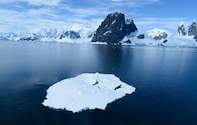First World Climate Conference
The first World Climate Conference was held in Geneva, Switzerland. The year 1981 was declared the warmest on record and the scientific community entered the 1980s by calling on governments to take action. Science now also understood that there were other ways to get around the troublesome issue of only having a few decades of reliable thermometer readings: they looked at proxy data to see how climate and atmospheric gases had changed through time.

Gas trapped in ice caps recorded hundreds of thousands of years of fluctuation. Tree rings showed shifts between cool unproductive years and warmer productive years, giving a shorter-term record. Pollen trapped in layers of ancient mud showed how vegetation had shifted its distribution in response to climate over thousands of years.
Likewise, by looking at the different species of plankton whose shell remains are trapped in limestone layers on the seabed, scientists could calculate which species thrived at different times and what the temperature must have been for them to have done so. Shell fossils in the seabed have provided temperature records going back a hundred million years.
Each aspect - ice, tree rings, pollen, seashells - provides a different timeline. Juxtaposed, the chronology of the planet's ancient climate emerges from the haze of the past. Carbon dioxide (CO ) from burning fossil fuel was also understood to be just one of the culprits in anthropogenic climate change.
Stronger Call for Action
The 1980s brought a call for stronger action. The Montreal Protocol showed that it was possible for global action to reduce emissions into the atmosphere by placing a cap on the production of ozone-depleting CFCs. Then 1988 achieved the new and dubious distinction of being the hottest year on record (which would later be surpassed by an even hotter 1998 and 2005), and the United Nations established the Intergovernmental Panel on Climate Change (IPCC).
Atmospheric carbon dioxide concentration was finally pegged down at 350 parts per million (ppm), which was up from the pre-industrial level of 280 ppm. A 500 ppm concentration was believed to be 'dangerous'.
A strict call was made for a reduction in greenhouse gas emissions but it was understood that the planet was already committed to a small amount of global climate change. The decade of the 1990s saw large-scale global collaboration among the scientific community through the IPCC. A 1992 meeting in Rio de Janeiro witnessed over a hundred countries signing the United Nations Framework Convention on Climate Change (UNFCCC), in which they acknowledged the climate system as a shared resource.
They produced the first global effort to curb global warming. The United States (US) signed the agreement. However, when in 1997 the members met to ratify the Kyoto Protocol - which committed members to set targets for emissions reduction - the US failed to sanction the agreement. Since the US is responsible for nearly a quarter of all global emissions, its lack of commitment to Kyoto remains one of the most contentious issues in the politics of climate change.
In 2001 the IPCC released the most up-to-date and comprehensive body of work, Climate Change 2001 - The Scientific Basis. The consensus, now, is that the planet is committed to dangerous global warming and yet the juggernaut of industrial growth seems unstoppable.
By Leonie Joubert